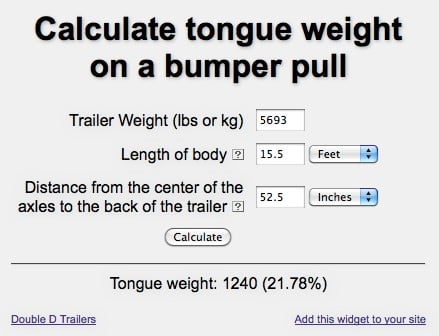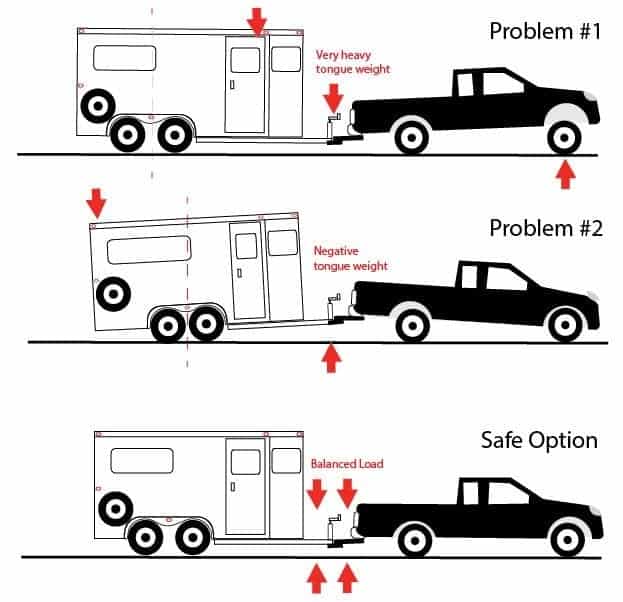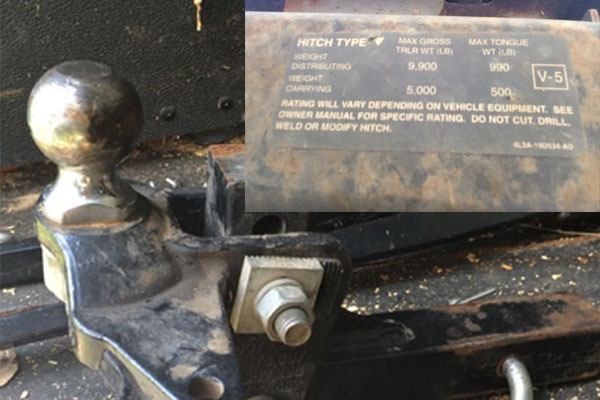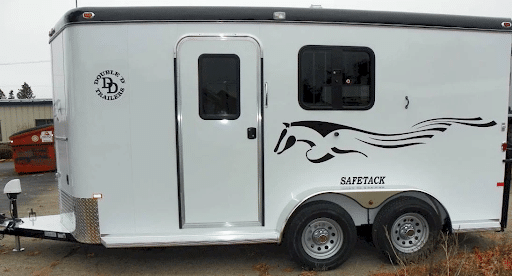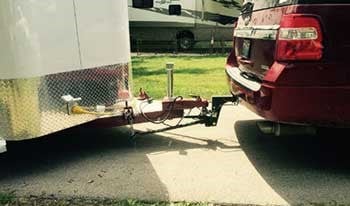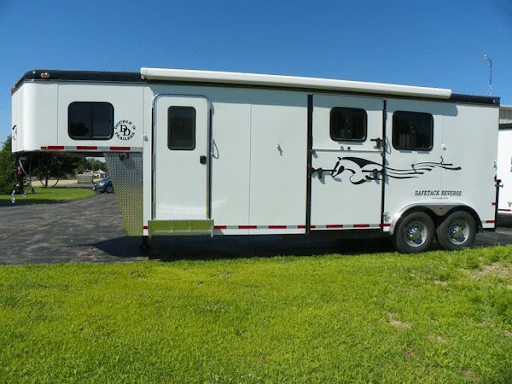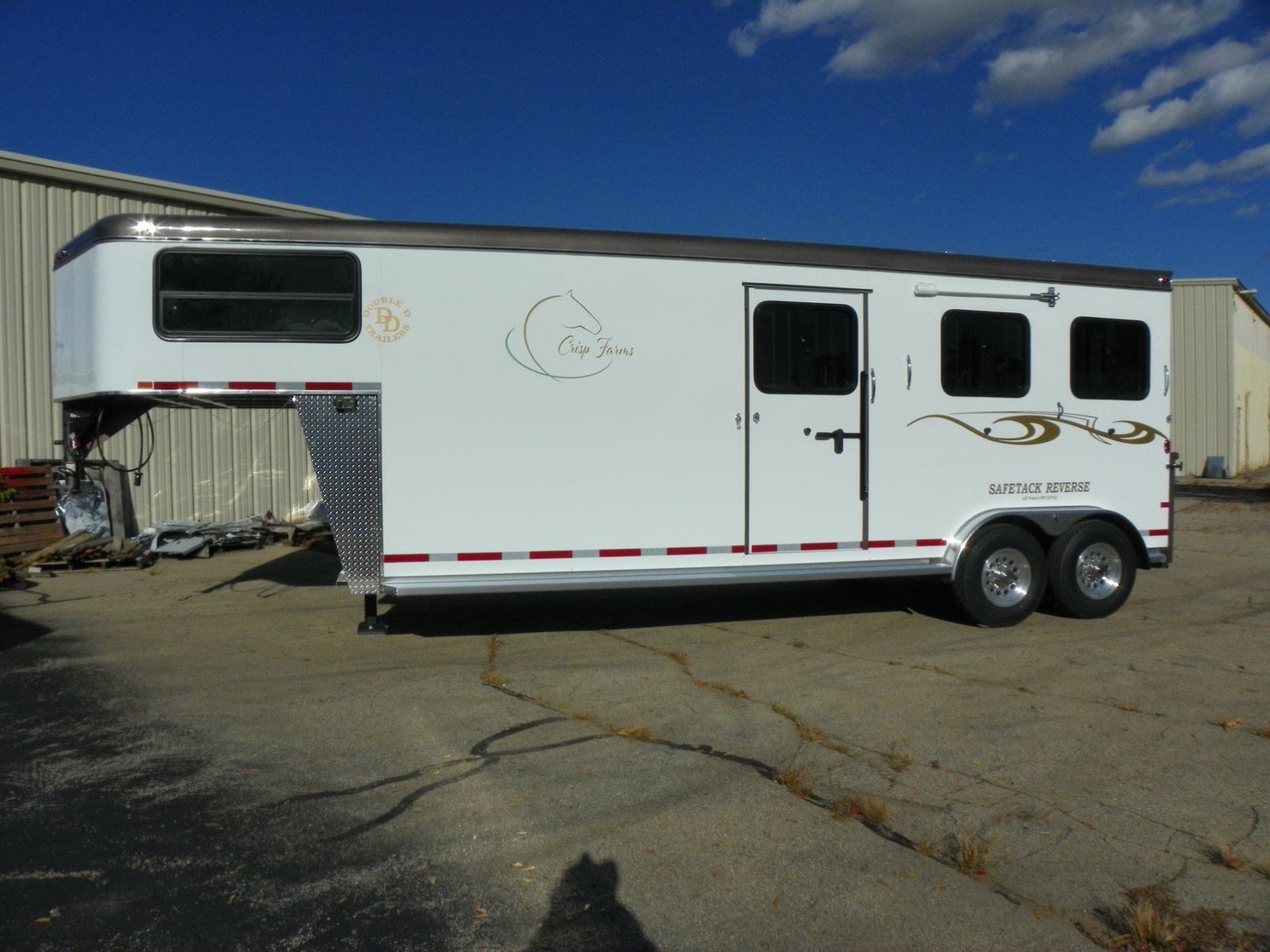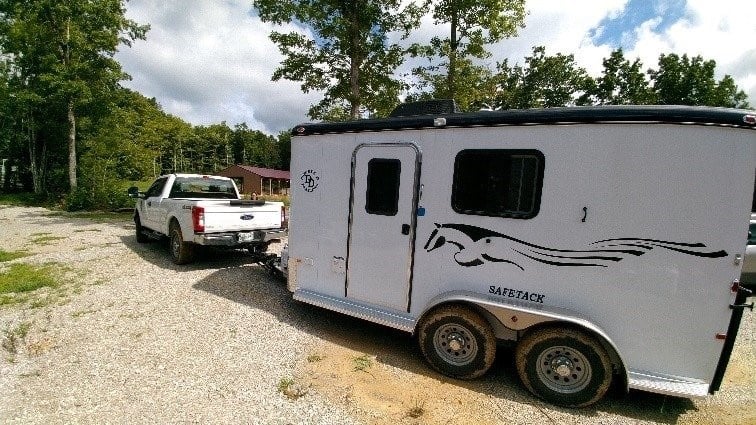Bumper Pull Living Quarters Trailers: Know the Dangers
In theory, a bumper pull horse trailer with living quarters should provide decent accommodation for both horses and humans in a compact-sized package that’s affordable and easy to maintain. In reality, gooseneck horse trailers are far better than bumper pull models with living quarters, not to mention the safety issues that occur the very second you hitch up the latter option. In this article, we’ll explain the reasons why you should avoid bumper pull living quarters horse trailers.
Bumper Pull With Living Quarters: The Appeal
What is a bumper pull horse trailer with living quarters? It’s basically a bumper pull model designed to provide living amenities for humans. Buyers who often attend multi-day horse shows or enjoy horse camping consider bumper pull horse trailers with living quarters to be the easiest, most convenient, and most affordable option. They’re often drawn to this configuration because they make assumptions such as:
- Bumper pull trailers with living quarters don’t necessarily require a pickup truck with a gooseneck hitch.
- Bumper pull models with living quarters are more compact and lightweight than goosenecks
Unfortunately, these living quarters add a great deal of weight to the front portion of the horse trailer which causes all sorts of problems. While a bumper pull trailer with living quarters may serve the horse and handler comfortably, finding a tow vehicle that is rated to safely tow the trailer is a huge concern.
At Double D Trailers, we’ve known for years that larger bumper pull trailers with living quarters greatly exceed the manufacturer’s tow ratings on most trucks. This is the root of possible safety issues that need to be avoided at all costs.
4 Hidden Dangers of Bumper Pull Horse Trailers with Living Quarters
We consider bumper pull horse trailers with living quarters to be unsafe due to a combination of factors that could rarely be ignored. Four hidden dangers outline the primary reasons why purchasing such a trailer is not a good idea, safety-wise.
1. Excessive Tongue Weight
Bumper pull horse trailers with living quarters are not safe to tow because the vertical tongue weight of these trailers is most often extremely heavy. It exceeds the hitch capacity on most tow vehicles. The front of the trailer is loaded with features like a kitchenette, bathroom, and sleeping quarters, resulting in a much heavier front end than a regular bumper pull trailer with a dressing room.
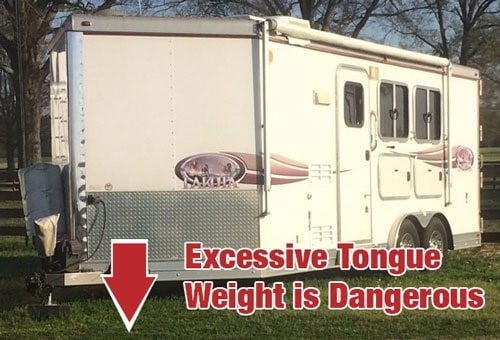
Many people make the mistake of checking their truck’s towing capacity, seeing a large GVWR value and assuming they are good to go. They forget to check the tongue weight capacity of their hitch. We strongly recommend reading our 3-step guide on how to properly hitch a horse trailer to ensure your safety on the road.
Hitches are only rated to pull a certain amount of weight and handle a specific vertical tongue weight. This is the weight of your trailer’s front section, or tongue if you were to walk up to the front and physically lift it off the ground. The tongue weight can be calculated using the trailer’s weight, body length, and axle position. Use our handy tongue weight calculator to make the calculations you need.
For example, we found one woman who owned a bumper pull living quarters horse trailer built by another manufacturer. Using the trailer’s weight, length, and axle locations, we were able to calculate that the tongue weight on her trailer, when empty of horses, was around 1,700 lbs.
The hitch on her Ford F-150 truck was only rated to carry 990 lbs. When she added another 2,200 lbs. of horses into the mix, she was likely exceeding her hitch’s maximum capacity by almost double! This is a very dangerous situation.
Most hitches, even with weight distribution bars, are only rated to haul around 1,500 lbs. of vertical tongue weight, so this trailer is bad news regardless of who tows it. And no, you can’t just get a larger hitch, as it would not solve this issue in question, as the truck’s payload would remain exceeded.
2. Variable Weight Distribution Due to Horse Placement
If putting living quarters on a bumper pull horse trailer is such a bad idea, why are enormous bumper pull RVs so common on the road? Do these camping enthusiasts have some sort of secret that horse people don’t know about? They do, actually: they are not hauling horses.
Loading horses into a bumper pull horse trailer adds a great deal of variability. RV designers can easily look at the placement of features in relation to the trailer axles to perfectly balance the load that largely remains fixed in position. Their goal is to achieve a 15% tongue weight. This means a 5,000-lb. RV would have an ideal tongue weight of around 750 lbs. That’s easily handled by many hitches.
Brad Heath, owner of Double D Trailers, helped explain the difference between RVs and horse trailers: “On a horse trailer that has an empty weight of 5,000 lbs., we can also work to achieve a 15% tongue weight. However, this load distribution is completely thrown off when we add 2,200 lbs. of horses to the mix.”
“If the horses are standing in front of the axles,” he continued, “then the tongue weight increases significantly. If they are standing behind the axles, then suddenly, you are at risk for a negative tongue weight that results in a swaying load or unstable driving conditions.”
Despite this fact, many horse trailer manufacturers have continued to build bumper pull living quarters horse trailers to meet the demands of consumers. It’s been a major point of concern for Brad who values horse trailer safety above all else in his business.
3. Reduced Tow Vehicle Steering and Handling
You may be wondering, "What’s the big deal if I exceed my hitch rating by a few hundred pounds?” Does matching the tongue weight to a proper hitch really matter that much? The short and definitive answer is “YES!”
If you have a trailer that is pushing down too much on the rear of your tow vehicle, you are at risk of a complete hitch failure. Brad explained, “There is a very good reason why vehicle manufacturers post limits on weight, and it’s to ensure safety, plain and simple. If you exceed that limit, it’s unsafe!”
Next, an excessively heavy load pushing on the rear of your tow vehicle also serves to lift the front end of your tow vehicle up slightly off the road. It’s just like a see-saw. Push down on one side and the other side goes up. This slight raising of the truck’s front end is enough to impact the steering on your tow vehicle.
4. Potential for Unclear or Misleading Specifications
If these trailers are so dangerous to tow, then why do people keep buying them? Unfortunately, many consumers are simply misinformed or even intentionally lied to. Sellers take advantage of inexperienced buyers and convince them that their truck can handle the load with no problem.
For years, Brad has been puzzled as to why companies continue to build these horse trailers knowing in good conscience that uneducated users are dangerously towing. In order to get to the bottom of the issue, he did a little bit of undercover investigation to talk with the sellers of these dangerous trailers. He concluded, “It was disheartening to find out that dealers would say everything but tell the truth when it comes to tongue weight!”
Bumper Pull Horse Trailer with Living Quarters: Safer Alternatives
A living quarters horse trailer is certainly wonderful to own. It gives you a warm and dry place to sleep after a long weekend showing the horses or traveling cross-country. It provides the comforts of home and saves time and funds by replacing hotels and restaurants simultaneously. Plus, it’s incomparable sleeping in a tent beside the trailer. No matter how you look at it, it’s downright convenient to shower off the mud of the day and cook a hot dinner right in your trailer.
If you are determined to own a living quarters horse trailer, check out one of the much safer and still affordable options below.
Why a One-Horse Design is the Safest Option For Bumper Pull Horse Trailers With Living Quarters
A one-horse bumper pull trailer with living quarters is the safest option if you’re certain that, regardless of the risks involved, this is the trailer type you want to purchase. The one-horse configuration might be the only safe solution to consider because of a few key factors, such as predictable and consistent weight distribution, reduced tongue weight, and better safety and stability.
Pull Type: Bumper Pull
Model: SafeTack 1 Horse Bumper Pull With Living Quarters
Living Quarters: Yes
Horse size: 1 horse
Stall size: Supports a horse up to a 15.2. (Option:16.2 Thoroughbred or 17 hand warmblood)
Living Quarters: 8 feet x 12 feet
*Ideal for one horse and one person
Starts at $56,661: MORE DETAILS
Consistent Weight Distribution
A one-horse bumper pull trailer with living quarters is designed to comfortably accommodate a single horse in a certain position, meaning that there’s no room to physically fit a second one and thus potentially overload the vehicle. When the horse area and stall are preliminarily designed with tongue weight in mind, there’s a good chance that even a heavier-than-average horse would not exceed the recommended tongue weight.
Reduced Tongue Weight
For the reason mentioned above, the estimated tongue weight of a single-horse bumper pull trailer would always be far less than a two-horse configuration, meaning that the trailer would be suitable for a wider array of tow vehicles, which makes it a more versatile choice, too.
Enhanced Safety and Stability
The reduced tongue weight and better weight distribution of one-horse bumper pull trailers with living quarters make this configuration the safest LQ bumper pull option possible. Since it’s shorter and lighter, such a trailer would be far more stable and predictable to pull and maneuver compared to a 2-horse bumper pull model with living quarters, for example, as long as the tow vehicle is appropriately rated.
SafeTack One-Horse Bumper Pull Trailer With Living Quarters
Yes, you read that right… a bumper pull with living quarters (but it is for only one horse!)
It is always our goal to build the perfect trailer for every type of horse owner out there. That’s why we’ve designed a new SafeTack One Horse Bumper Pull Horse Trailer with Living Quarters. This particular model has some really great advantages you may want to consider if you are looking for a new home away from home for you and your horse.
The SafeTack One Horse Bumper Pull Horse Trailer with Living Quarters offers a comfortable place to sleep or hang out while spending a weekend away at a show or camping trip. Sure, you could buy a larger gooseneck trailer with living quarters, but that seems like too much when it’s just you and your only horse.
This model boasts a comfy living area complete with a toilet, cooking area, dining area, and even a place to sleep. It’s the perfect little oasis for a single horse owner on the go. Plus, it’s compact and has reasonable tongue weight, allowing you to “hitch-and-go” and safely pull it without worrying about uneven weight or tight spaces for maneuvers. Again, the right tow vehicle plays a key part in the safety equation - it’s never just about the trailer’s clever design.
Gooseneck Trailers with Living Quarters Are Safer Alternatives For Hauling Multiple Horses
Gooseneck trailers with living quarters and space for two, three, or more horses are the much safer alternative to bumper pull models with identical horse capacity. Thanks to the entirely different hitch type, the extreme tongue weight issue is no longer present. There are other reasons why the gooseneck LQ designs would always be better than the bumper pull ones, including better towing capacity, improved stability, and enhanced loading and unloading.
Increased Towing Capacity
Gooseneck horse trailers with living quarters can accommodate 2, 3, or even 4 horses and still be reasonably sized and very safe to tow, unlike bumper pull LQ designs with a similar capacity. For this to happen, the pickup truck destined to pull the trailer must have adequate hitch and payload capacity, of course.
Greater Stability and Weight Distribution
The stability of gooseneck trailers with living quarters compared to bumper pulls with a comparable load capacity is far greater thanks to the much better weight distribution and the specific hitch design that places weight on the rear axle of the tow vehicle instead of the bumper. Therefore, goosenecks allow for tighter turns and are not prone to fishtailing, unlike bumper pulls, especially models equipped with heavy living space amenities.
Stress-Free Loading and Unloading With Full Walk-on Walk-off Layout
Another major advantage of gooseneck horse trailers with living quarters over bumper pull models with living quarters is the easy and safe “Walk-on, walk-off” loading and unloading pattern. This allows for forward or rear-facing orientation. Either way, horses would never need to be back up for unloading, which equals less physical and emotional stress for them.
Trail Blazer Gooseneck Living Quarters Trailer
This popular two-horse trailer with living quarters allows you to pick and choose where you spend your money. Rather than buying one of the fancier models, this trailer comes with a base model ready to haul 2 or 3 horses up to 16.2 hands in height. It’s fully customizable too - for example, adding a side loading door and ramp boosts the model’s versatility by allowing for a “Walk-on, walk-off” configuration and any load pattern. Most 3/4 pickup trucks can safely tow this trailer.
It also comes with all the safety features you’d want on a Double D Trailer, which includes:
- Z-Frame Technology®️
- Galvalite skin
- “No Leak” SafeBump Roof®️
- Temperature regulation
- SafeKick®️ Wall System
This gooseneck trailer also includes the patented SafeTack storage area. Unlike most conventional slant load trailers, SafeTack trailers have a rear tack storage area that swings out like a second door. This leaves you with a wide-open doorway for loading, unloading, and even turning the horse around when needed.
The mid-sized living quarters area has a short wall that ranges from 7 to 9 feet. The interior of the trailer comes with vinyl-wrapped cabinets and a fold-out sleeper sofa. You can also customize the kitchen area and layout to match your preferences, as well as order specific horse area dimensions.
Pull Type: Gooseneck
Model: Trail Blazer
Living Quarters: Yes
Horse size: 2-3 horses up to 16.2 hands in height (Option: additional width and height to handle 17+ hand horses)
Stall size: 9 ft 9 in diagonal length; 7 ft 7 in divider length; 3 ft 4 in width measured at windows, 2 ft 7 in at padding
Dress side: 7' short wall x 11' long wall
Living Quarters: Mid-sized with short wall options ranging from 7 ft to 9 ft in length
*Pricing allows for flexibility in choosing which features you’d like to upgrade.
Starts at $69,353: MORE DETAILS
The Basics Horse Trailer with Living Quarters
A major reason why people shy away from a full living quarters gooseneck trailer is the price. So, why not start with a basic gooseneck trailer that has all your essential features - running water (with a water heater), shower, kitchen sink, a closet along with storage cabinets and a bench seat! All of these come with The Basics Living Quarters horse trailer.
Best of all, this trailer model is much safer than the two or three-horse bumper pull living quarters options described above. You can spec one of these trailers to haul between 2-4 horses and keep it reasonably priced. The cost is much less than a full living quarters and the end result is a trailer you’ll love.
Pull Type: Gooseneck
Model: Basics LQ
Living Quarters: Yes
Horse size: Customizable to fit up to a 17.2 Hand Warmblood
Stall size: Standard fits up to a 15.2 1100 lb. smaller breed
Dress side: 4 ft short wall x 8 ft long wall
Living Quarters: Basic needs, no frill
*Available in 2-horse, 3-horse, or 4-horse
Starts at $55,706: MORE DETAILS
Learn More About Safe and Comfortable Horse Transportation
Even if you choose the safest and most appropriate horse trailer with living quarters that’s full of options and fits your needs to the fullest, there are other considerations to make to achieve the ultimate safety in horse transportation, such as horses’ well-being during travel.
The Importance of Proper Trailer Selection
Selecting the best horse trailer for you and your horses is no easy task. It involves a ton of factors to take into account, all of which are included in our detailed guide on buying a safe horse trailer. These factors include:
- Number and size of your horses: The trailer you pick should offer a welcoming, spacious horse area and wide enough stalls to comfortably accommodate your horses
- Available customization options: Off-the-lot models would likely not be suitable for your needs, meaning that a custom horse trailer built to your exact specification is the better choice
- Materials and fabrication processes: The ultimate safety of a horse trailer largely depends on the proper manufacturing methods and materials it comprises
How To Ensure the Well-Being of Your Horse During Travel
Your horses’ well-being during transport depends on numerous circumstances and factors but you have the power to create the best possible environment for them by choosing a well-designed and equipped trailer and taking advantage of important safety tips such as:
- Ensure the horse area is properly ventilated and has sufficient illumination: Horses despise dark, confined spaces and they need all the fresh air they can get, so having a bright interior with plenty of lighting and windows, alongside vents, fans, or ideally air conditioning is key
- Choose a trailer with loads of safety perks: A truly safe horse trailer should come with plenty of safety options such as an insulated roof, padded walls and dividers, non-slip floors and ramps, and a monitoring system
- Never exceed manufacturers’ recommendations: Even weight distribution of the load inside the trailer is key for safe towing, alongside confirming the tow vehicle’s compatibility with the trailer in terms of tongue weight and payload
Contact Our Experts for Personalized Advice
Brad Heath, owner and head designer of Double D Trailers, has spent nearly 30 years pursuing the ultimate safety and comfort of horse trailers. His experience and expertise in designing and building horse trailers, alongside his vision and ideas, have resulted in numerous industry-specific innovations and patented features, some of which remain exclusive to the Double D Trailers brand.
If you want to take advantage of our team's knowledge, you’re welcome to contact us for a free consultation. You’ll learn about the dos and don’ts of buying a horse trailer and discover the vast customization options available for all Double D Trailers models. It’s the ultimate vantage point in your search for the perfect horse trailer.

